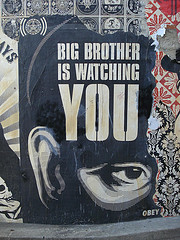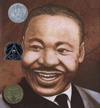Top 10 Things to Do with a Banned Text
September 20, 2010
 How will you discuss Banned Books Week (BBW) this year? It’s easy to find ideas for displays and activities for libraries. The problem is that most of them are too general or would be difficult to use in the writing classroom.
How will you discuss Banned Books Week (BBW) this year? It’s easy to find ideas for displays and activities for libraries. The problem is that most of them are too general or would be difficult to use in the writing classroom.
To solve that problem, I began brainstorming ways that students can think critically about censorship. The result is this collection of projects that focus primarily on argument and persuasion. When possible, I tried to think of options that allow students to speak their own minds, for or against limiting access to a text.
So here are the top ten things to do with a banned book—other than read it, of course!
- [Mock Trial] Put the author of the banned book on trial (or a character from the text). Let Gustave Flaubert’s experience with Madame Bovary be your inspiration. You can adapt Mock Trial resources and the ALA’s suggestions for conducting a challenge hearing for the project.
- [PSA] Make a Public Service Announcement (PSA) that supports the text and the freedom to read (or BBW). You can create a video, audio, or slide show PSA. There are audio examples at the ALA site. Your announcement can focus on BBW as a whole or might be a campaign for the freedom to read a particular text.
- [Character Diary] Write a diary entry from the perspective of a character from a banned text. The character may be one whose actions are cited when people talk about banning the book or someone else in the text. There’s a List of Ten Character Diary Prompts you can use if you want to extend this activity.
Adapt this writing prompt for students: Someone wrote the story of your life, and the book has been banned from _____ because of _____. Write your reaction as a diary entry—Are you shocked? pleased? upset? Do you think the banning was fair?
- [Warning] Create a warning label for a banned text. Examine that appearance and wording of warnings that are added to movie and television shows, cigarettes, and prescription drug commercials and ads. Have students then create a label that would be placed on the cover of the text. The label can be realistic or satirical. Here’s an example for Huck Finn and some additional tips on designing warning labels you can use to supplement discussion.
Introduce the Warning Label Generator to add some play to the project. The images may not match properly, but the tool is fun. And if students think no one would ever put a warning on a book, you can share “Ratings, warning labels don’t belong on books.”
- [Testimonial] Write a testimonial letter or blog entry that explains why you support (or don’t) a banned text. Your goal is to convince readers to read (or not read) the text. Alternately, you can argue that the text be kept (or not kept) in the school or public library or read by students in a particular class.
Your testimonial needs to personal, based on your experiences and beliefs. This is your chance to make a personal statement about why the text should (or shouldn’t) be read.
- [Language of Persuasion] Choose a statement for or against banned text, and examine how the language contributes to the argument. These questions can guide your analysis:
- How are specific examples from the text used? When and to what effect?
- What about euphemisms — how do the authors sugarcoat or generalize their messages with their word choice?
- What about their sense of audience? Do they understand their readers? How can you tell?
After you’ve examined the language, compose a blog entry, podcast, or video presentation that analyzes the authors’ language, explaining what you can conclude about their goals, their sense of audience, and their ideas on the issues.
- [A Fable] Have each student brainstorm a list of things that might happen if a text is banned from a library or classroom. You can focus on a specific text or just banned books in general. Next, students share their lists with the class, and identify the items that recur and those that seem particularly significant or surprising. Ask each student to choose an item to focus on, and write a fable that tells the story of the banned text and ends with or discusses the item chosen from the class lists. The moral of the fable will be related to whether books should (or shouldn’t) be banned.
- [Biggest Myth] What is the biggest myth that you’ve heard in the media about a banned book? Write a letter to the editor, to the television show, or to the general public that explains why you disagree with the coverage they have given to the myth you’ve identified.
In your letter, describe the myth that you’ve heard and read, explain why you believe the assertion is untrue, and suggest reasons that the myth has developed. Identify and share more realistic explanations. Persuade your readers to change the way that they talk about the banned text.
- [Investigative Report] Describe the book banning in the form of an investigative report—the kind of piece you’d hear on 60 Minutes, Dateline, or 20/20. Start with a question or issue that the banning focuses on, explain all of the facts and details that you uncover in relationship to the issue, and conclude with the insights you gain as a result of your investigation.
Like an investigative report on TV, your report should stir your reader to some kind of implicit action as a part of the conclusion — the point might be to stir the reader’s emotions, to inspire the reader to challenge the banning, or to suggest that the reader take an active role in how books are chosen for the library or classroom.
- [Censor It] Identify passages from a banned text that have been cited for using inappropriate language. Have students work in small groups to rewrite the sections. Ideally each group should have a different section of text to work with. Collect the two versions of the passages. Share the rewritten version of each passage with the whole class first, and then reveal the original version. Talk about what is lost (or not) in the censored versions.
Use the activity to talk about how rewriting, expurgation, and omission are used as a way to talk about banned texts. Class discussion can include:
- Radio versions of songs that get air play versus original versions with explicit lyrics.
- Beeping out words in audio and video broadcasts.
- Blocking images with a black box or blurred area in television broadcasts.
- Adding a “clean” voiceover for inappropriate words said in a movie played on television (e.g., “shoot” for “shit”).
- Cutting scenes and events from a movie before playing it on broadcast television.
- The name of the CBS sitcom referred to as “Stuff My Dad Says” when spoken and often shown in print as $#*! My Dad Says. (The show based on the Twitter feed Shit My Dad Says and the related book Sh*t My Dad Says.)
For some specific lesson plans, see ReadWriteThink’s calendar entry for Banned Books Week. Check out my Bedford Bits post for Persuasion, Argument, and Book Banning in 10 Steps.


 i
i